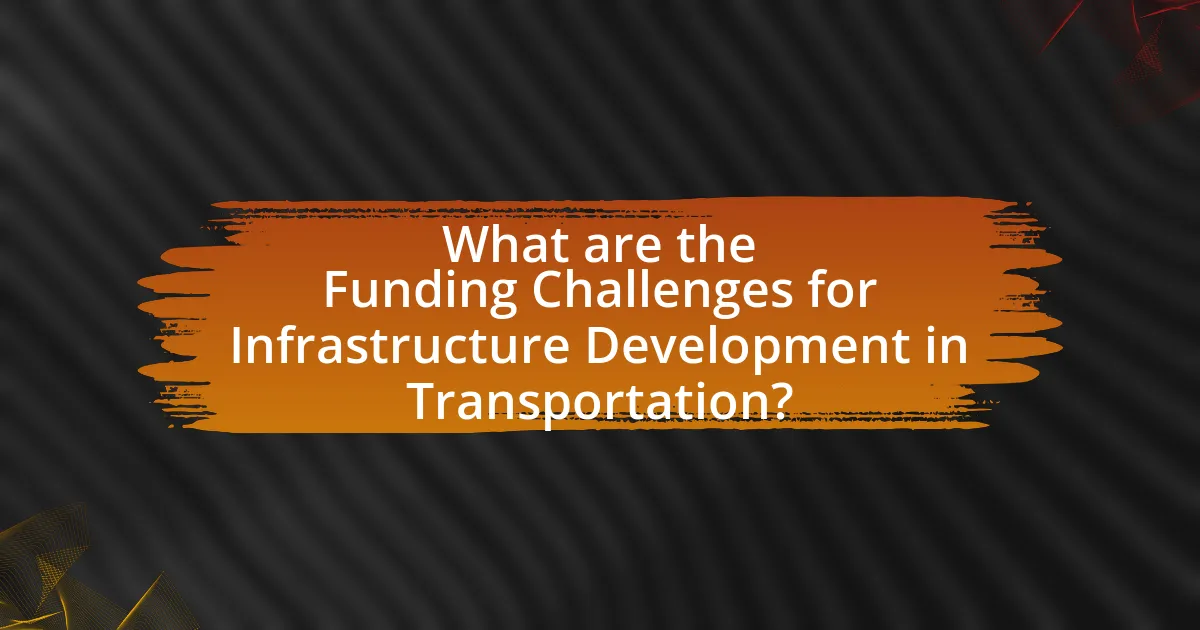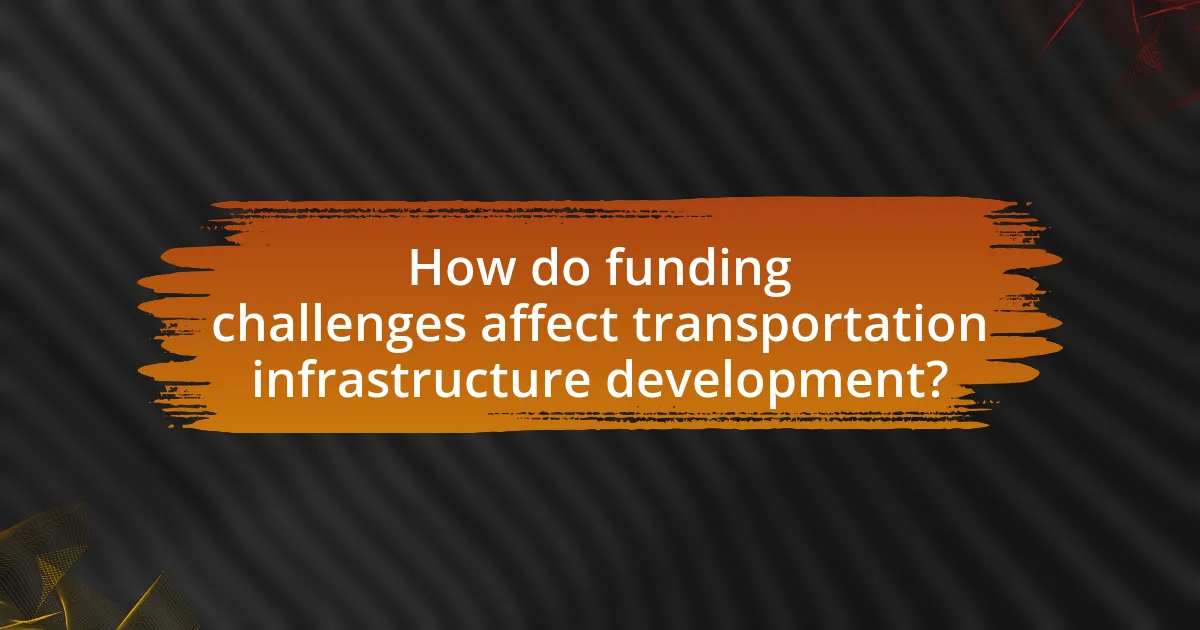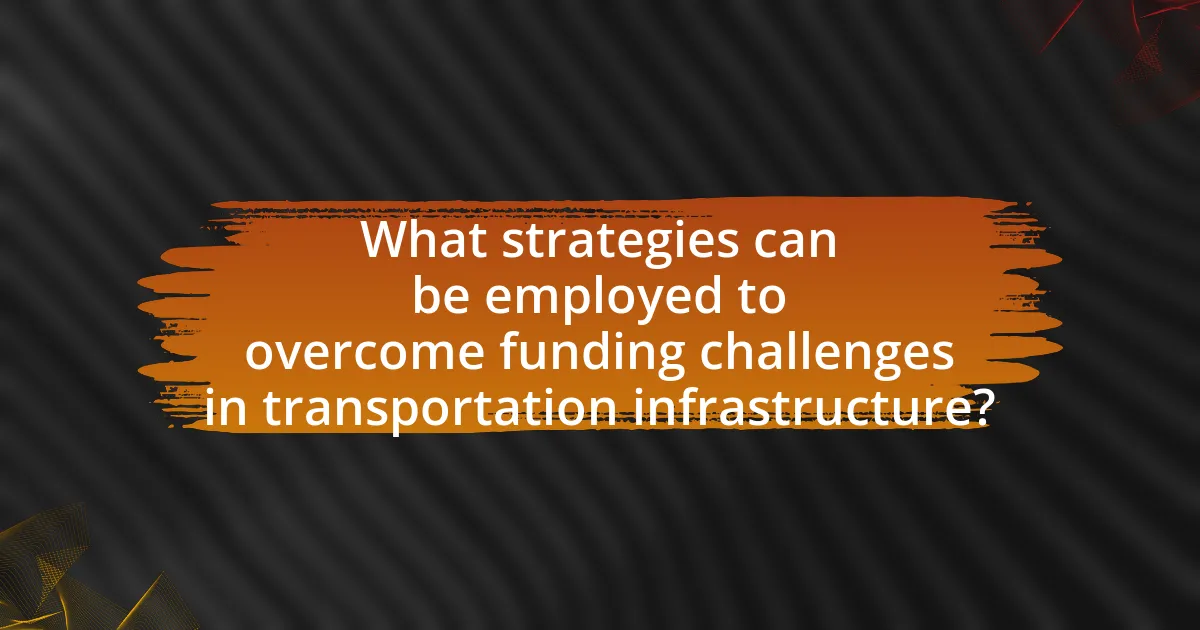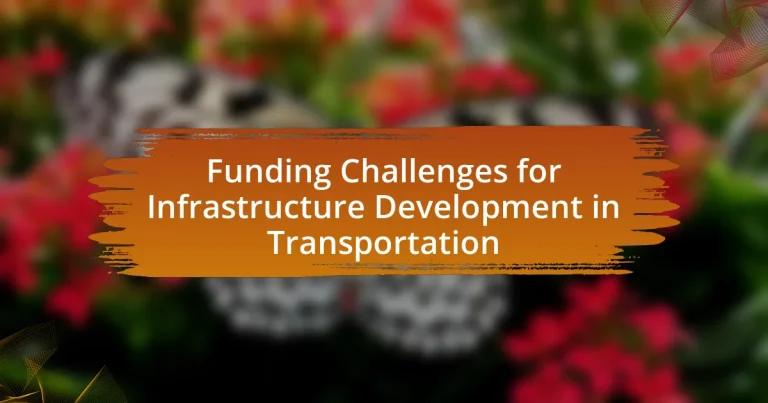The article focuses on the funding challenges faced in infrastructure development for transportation, highlighting issues such as limited public funding, rising construction costs, and complex financing mechanisms. It emphasizes the critical role of government funding and private investments in supporting transportation projects, while also discussing common funding sources and the impact of economic downturns on funding availability. Additionally, the article explores innovative funding models, regulatory hurdles, and strategies to overcome these challenges, ultimately underscoring the urgent need for effective funding solutions to enhance transportation infrastructure quality and efficiency.

What are the Funding Challenges for Infrastructure Development in Transportation?
Funding challenges for infrastructure development in transportation primarily include limited public funding, rising construction costs, and the complexity of financing mechanisms. Limited public funding arises from budget constraints faced by governments, which often prioritize immediate needs over long-term infrastructure projects. Rising construction costs, influenced by inflation and supply chain disruptions, further strain available resources. Additionally, the complexity of financing mechanisms, such as public-private partnerships, can deter investment due to perceived risks and regulatory hurdles. According to the American Society of Civil Engineers, the U.S. alone faces a $2.59 trillion funding gap for infrastructure by 2029, highlighting the urgency of addressing these challenges.
Why is funding critical for transportation infrastructure development?
Funding is critical for transportation infrastructure development because it provides the necessary financial resources to design, construct, and maintain essential transportation systems. Without adequate funding, projects can face delays, reduced scope, or complete cancellation, leading to deteriorating infrastructure and increased safety risks. For instance, the American Society of Civil Engineers reported that the U.S. requires an investment of $4.5 trillion by 2025 to improve its infrastructure, highlighting the urgent need for funding to address existing deficiencies and support future growth.
What role does government funding play in transportation projects?
Government funding is crucial for transportation projects as it provides the necessary financial resources to initiate, develop, and maintain infrastructure. This funding supports various aspects, including construction, upgrades, and operational costs, ensuring that transportation systems are efficient and safe. For instance, the Federal Highway Administration reported that federal funding accounted for approximately 52% of total highway capital outlays in the United States in 2020, highlighting the significant reliance on government resources for transportation infrastructure.
How do private investments influence transportation infrastructure?
Private investments significantly influence transportation infrastructure by providing essential funding and resources that often exceed public sector capabilities. These investments enable the development of new projects, such as highways, rail systems, and airports, which can enhance connectivity and efficiency. For instance, the Public-Private Partnership (PPP) model has been utilized in various countries, allowing private entities to finance, build, and operate transportation facilities, thereby accelerating project timelines and reducing public expenditure. According to a report by the World Bank, PPPs have led to improved infrastructure quality and service delivery in multiple regions, demonstrating the effectiveness of private capital in addressing funding challenges in transportation development.
What are the common sources of funding for transportation infrastructure?
Common sources of funding for transportation infrastructure include federal and state government allocations, local taxes, public-private partnerships, and grants from various organizations. Federal funding often comes from programs like the Highway Trust Fund, which supports road and transit projects, while state governments may allocate budgets specifically for infrastructure improvements. Local taxes, such as sales taxes or property taxes, can also be directed toward transportation projects. Public-private partnerships leverage private investment to fund infrastructure development, allowing for shared risk and resources. Additionally, grants from organizations like the Federal Transit Administration and the Department of Transportation provide financial support for specific projects, enhancing overall funding availability.
What types of public funding are available for transportation projects?
Public funding for transportation projects primarily includes federal grants, state funding, local government contributions, and public-private partnerships. Federal grants, such as those from the Federal Highway Administration and the Federal Transit Administration, provide significant financial support for infrastructure development. State funding often comes from dedicated transportation funds, which are generated through fuel taxes and vehicle registration fees. Local governments may also allocate funds from their budgets or through bonds to support transportation initiatives. Public-private partnerships leverage private investment to complement public funding, facilitating the development of transportation infrastructure. These funding sources are essential for addressing the financial challenges associated with infrastructure development in transportation.
How do public-private partnerships contribute to funding?
Public-private partnerships (PPPs) contribute to funding by leveraging both public and private sector resources to finance infrastructure projects. These collaborations allow for shared investment risks, enabling the mobilization of private capital for public infrastructure, which is often constrained by budget limitations. For instance, according to the World Bank, PPPs can reduce the financial burden on governments while enhancing project efficiency and innovation through private sector expertise. This model has been successfully applied in various transportation projects, such as toll roads and transit systems, where private entities provide upfront capital in exchange for future revenue streams, thus facilitating timely project completion and improved service delivery.
What specific challenges do funding sources face in transportation infrastructure?
Funding sources face significant challenges in transportation infrastructure primarily due to budget constraints and competing priorities. Limited financial resources often lead to difficulties in securing adequate funding for large-scale projects, as governments and agencies must balance transportation needs with other essential services. Additionally, fluctuating economic conditions can impact revenue streams, such as fuel taxes and tolls, which are critical for funding infrastructure. According to the American Society of Civil Engineers, the U.S. requires an estimated $2.59 trillion investment in transportation infrastructure over the next decade to maintain and improve systems, highlighting the urgency of addressing these funding challenges.
How do economic downturns impact funding availability?
Economic downturns significantly reduce funding availability for infrastructure development in transportation. During such periods, government revenues decline due to lower tax collections, leading to budget cuts and reduced public investment in infrastructure projects. For instance, the 2008 financial crisis resulted in a 20% decrease in state and local government capital spending on transportation infrastructure, as reported by the Federal Reserve Bank of New York. Additionally, private investors become more risk-averse during economic downturns, leading to a decrease in private funding for infrastructure projects. This combination of reduced public and private funding creates substantial challenges for financing transportation infrastructure during economic downturns.
What regulatory hurdles affect funding for transportation projects?
Regulatory hurdles that affect funding for transportation projects include lengthy permitting processes, compliance with environmental regulations, and the need for extensive public engagement. These hurdles can delay project timelines and increase costs, making it challenging to secure financing. For instance, the National Environmental Policy Act (NEPA) requires federal agencies to assess the environmental impacts of proposed projects, which can take years to complete. Additionally, state and local regulations may impose further requirements, complicating the funding landscape. According to the U.S. Government Accountability Office, these regulatory complexities can lead to significant delays, with some projects experiencing timeframes that extend beyond a decade before funding is finalized.

How do funding challenges affect transportation infrastructure development?
Funding challenges significantly hinder transportation infrastructure development by limiting the availability of financial resources necessary for project initiation and completion. Insufficient funding leads to delays in construction timelines, reduced project scopes, and the inability to maintain existing infrastructure. For instance, the American Society of Civil Engineers reported that the U.S. faces a $2.59 trillion funding gap for infrastructure improvements over the next decade, which directly impacts the quality and safety of transportation systems. Consequently, inadequate funding not only stifles new projects but also exacerbates existing issues, resulting in increased congestion and higher maintenance costs in the long run.
What are the consequences of inadequate funding for transportation projects?
Inadequate funding for transportation projects leads to delayed infrastructure improvements and increased maintenance costs. When funding is insufficient, essential projects such as road repairs, public transit upgrades, and safety enhancements are postponed, resulting in deteriorating conditions that can compromise safety and efficiency. For instance, the American Society of Civil Engineers reported in 2021 that the U.S. faces a $2.59 trillion investment gap in infrastructure, which exacerbates congestion and increases travel times. Additionally, inadequate funding can limit access to reliable transportation options, disproportionately affecting low-income communities and hindering economic growth. The lack of investment in transportation infrastructure can also lead to higher long-term costs, as deferred maintenance often results in more expensive repairs down the line.
How does insufficient funding lead to project delays?
Insufficient funding leads to project delays by limiting the resources available for timely execution. When a project lacks adequate financial support, essential activities such as hiring skilled labor, purchasing materials, and maintaining equipment are hindered. For instance, a study by the American Society of Civil Engineers indicates that 40% of infrastructure projects experience delays due to budget constraints, which directly impacts project timelines. Consequently, insufficient funding creates a domino effect, causing postponements in project milestones and overall completion.
What impact does lack of funding have on infrastructure quality?
Lack of funding significantly deteriorates infrastructure quality. Insufficient financial resources lead to delayed maintenance, reduced construction standards, and the inability to implement necessary upgrades. For instance, the American Society of Civil Engineers reported in 2021 that the U.S. faces a $2.59 trillion investment gap in infrastructure, resulting in crumbling roads, bridges, and transit systems. This lack of investment directly correlates with increased safety hazards and decreased efficiency in transportation networks, ultimately affecting economic growth and public safety.
How do funding challenges influence project planning and execution?
Funding challenges significantly impact project planning and execution by limiting available resources, which can lead to delays and scope reductions. When financial constraints arise, project managers often have to prioritize certain aspects of the project over others, potentially compromising quality or functionality. For instance, a study by the American Society of Civil Engineers indicates that inadequate funding can result in a 20% increase in project timelines due to necessary adjustments and re-evaluations. Additionally, funding issues can lead to a lack of stakeholder confidence, which may further complicate project execution and hinder future investment opportunities.
What adjustments do planners make in response to funding limitations?
Planners adjust project scopes, timelines, and priorities in response to funding limitations. They may reduce the scale of projects, opting for essential features only, or extend timelines to spread costs over a longer period. Additionally, planners often prioritize projects based on urgency and potential impact, ensuring that the most critical infrastructure needs are met first. For instance, a study by the American Society of Civil Engineers highlights that many transportation projects are scaled back or delayed due to budget constraints, emphasizing the need for strategic planning in resource allocation.
How do funding challenges affect stakeholder engagement?
Funding challenges significantly hinder stakeholder engagement by limiting resources available for communication and collaboration. When funding is insufficient, organizations often struggle to maintain regular interactions with stakeholders, which can lead to misunderstandings and decreased trust. For instance, a study by the American Society of Civil Engineers indicates that inadequate funding for infrastructure projects can result in reduced stakeholder participation in planning processes, ultimately affecting project outcomes. This lack of engagement can further exacerbate funding issues, as stakeholders may become less willing to support initiatives that do not address their concerns or involve them adequately.

What strategies can be employed to overcome funding challenges in transportation infrastructure?
Public-private partnerships (PPPs) can effectively overcome funding challenges in transportation infrastructure. These collaborations leverage private sector investment and expertise to finance, build, and operate transportation projects, reducing the financial burden on public entities. For instance, the U.S. Department of Transportation reported that PPPs have successfully funded over $200 billion in infrastructure projects, demonstrating their viability. Additionally, innovative financing mechanisms such as value capture, where increased property values near new infrastructure are taxed to fund the project, can also provide necessary capital. This approach has been utilized in cities like San Francisco, where transit-oriented development has generated significant revenue for transportation improvements.
What innovative funding models are being explored for transportation projects?
Innovative funding models being explored for transportation projects include public-private partnerships (PPPs), value capture financing, and mobility as a service (MaaS). Public-private partnerships leverage private investment to fund infrastructure while sharing risks and rewards, as seen in projects like the I-595 corridor in Florida, which utilized a PPP to expedite construction and reduce costs. Value capture financing involves generating revenue from increased property values near transportation projects, exemplified by the Denver FasTracks program, which funded transit expansion through tax increment financing. Mobility as a service integrates various transportation services into a single accessible platform, potentially funded through subscription models or usage fees, as demonstrated by initiatives in cities like Helsinki. These models address funding challenges by diversifying revenue sources and enhancing project sustainability.
How can technology improve funding mechanisms for infrastructure?
Technology can improve funding mechanisms for infrastructure by enabling more efficient data collection and analysis, which enhances decision-making and transparency. For instance, blockchain technology can facilitate secure and transparent transactions, reducing fraud and increasing trust among stakeholders. Additionally, data analytics can identify funding gaps and prioritize projects based on economic impact, leading to better allocation of resources. According to a report by the World Economic Forum, the integration of technology in infrastructure funding can lead to a 20% reduction in project costs and a 30% increase in project delivery speed, demonstrating its effectiveness in optimizing funding mechanisms.
What role do community initiatives play in funding transportation projects?
Community initiatives play a crucial role in funding transportation projects by mobilizing local resources, fostering public engagement, and leveraging community support. These initiatives often involve grassroots efforts that identify specific transportation needs, which can lead to the development of funding proposals that resonate with local stakeholders. For instance, community-led campaigns can successfully advocate for funding through local government budgets or state and federal grants, as seen in various successful projects across the United States. Additionally, community initiatives can facilitate partnerships with private entities, enhancing financial contributions and support for transportation projects. This collaborative approach not only increases funding opportunities but also ensures that projects align with the community’s needs and priorities, ultimately leading to more sustainable and effective transportation solutions.
What best practices can be adopted to secure funding for transportation infrastructure?
To secure funding for transportation infrastructure, stakeholders should adopt a multi-faceted approach that includes building strong partnerships, demonstrating project viability, and leveraging diverse funding sources. Establishing collaborations with government agencies, private sector partners, and community organizations enhances credibility and resource sharing, which is essential for successful funding applications. Additionally, presenting comprehensive feasibility studies and cost-benefit analyses can effectively showcase the project’s potential impact and sustainability, making it more attractive to investors and funding bodies. Utilizing a mix of funding sources, such as federal grants, state funds, public-private partnerships, and innovative financing mechanisms, diversifies financial support and mitigates risks associated with reliance on a single funding stream. These practices are supported by the Federal Highway Administration’s guidelines, which emphasize the importance of strategic planning and stakeholder engagement in securing infrastructure funding.
How can effective project proposals attract funding?
Effective project proposals attract funding by clearly articulating the project’s objectives, benefits, and feasibility, which instills confidence in potential funders. A well-structured proposal includes a detailed budget, timelines, and measurable outcomes, demonstrating the project’s viability and alignment with funding priorities. For instance, according to a study by the National Institute of Transportation and Communities, projects that present clear economic benefits and community impact are 30% more likely to secure funding. This evidence underscores the importance of presenting a compelling case that resonates with the interests of funding organizations.
What strategies can enhance collaboration between public and private sectors?
Public-private partnerships (PPPs) are effective strategies that can enhance collaboration between public and private sectors. These partnerships leverage the strengths of both sectors, allowing for shared resources, expertise, and risk management. For instance, the U.S. Department of Transportation has successfully utilized PPPs to fund infrastructure projects, resulting in over $10 billion in investments since 2009. Additionally, establishing clear communication channels and joint governance structures can facilitate better alignment of goals and expectations, further strengthening collaboration.
What are the key takeaways for addressing funding challenges in transportation infrastructure?
Key takeaways for addressing funding challenges in transportation infrastructure include diversifying funding sources, leveraging public-private partnerships, and implementing innovative financing mechanisms. Diversifying funding sources, such as federal, state, and local government contributions, ensures a more stable financial base. Public-private partnerships can enhance investment by sharing risks and resources, as evidenced by successful projects like the I-495 Capital Beltway in Virginia. Innovative financing mechanisms, such as value capture and tolling, can generate additional revenue streams, demonstrated by the use of tolls on the SR 520 Bridge in Washington State, which helped fund its construction. These strategies collectively enhance the financial viability of transportation infrastructure projects.


